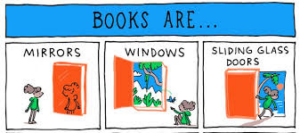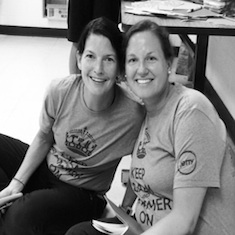Back-to-school night in my district is a scheduling house of cards. Families try to follow their child’s complete “A Day” school schedule in roughly one hour, often dividing and conquering to do this for multiple children. If they are successful in this mission and actually make it to my presentation during the correct window of time, I have 10 minutes to share the essence of seventh-grade literacy: the units I’ll teach, the classroom routines, my expectations, the class books we’ll read, and how my beliefs are woven into my teaching. Inevitably, some of these things fall by the wayside, and I decide to share some information on a slideshow that I can email, but one thing that I never omit is the importance of parents staying involved in their children’s reading lives.
In seventh grade, families can start to feel like this isn’t as important. There are so many teachers and subjects, and parents assume that their kids already know how to read and have solidified their reading identities: They see themselves as either a kid who likes to read or one who doesn’t.
While time is tight during back-to-school night, I need to dedicate time to encouraging parents to stay active in their children’s reading lives. After all, there is a lot at stake.
Did you know that 33 percent of high school graduates never read a book after graduation? Research also shows that a student reading below grade level at the end of third grade is four times less likely to graduate high school on time. Jason Reynolds, author of many books and poems, confesses to never having read a full novel until he was 17 years old. Given how much I love Jason Reynolds’s books and the way he has opened up a world of literacy for so many people, I am especially grateful that he beat the statistics and was only a late bloomer. How can we, as educators, convince parents and students and administrators of the importance of “just” reading?
During back-to-school night, I use part of the precious 10 minutes I have with families to share the power of words encountered in reading. I use data to hammer down my point, using a bar graph to show how many words a person will encounter based on the number of minutes they spend reading per day. It also correlates the time spent reading to average test scores.
But it’s more than test scores. There are so many reasons to read.
There are physiological benefits similar to meditation, including lowering stress and better sleep. In fact reading for six minutes has been shown to reduce stress levels by 68 percent. In an age where more and more children at younger and younger ages struggle with anxiety, how can we not take advantage of this benefit?
There are emotional benefits as well that include helping us understand ourselves, the world around us, and others. I love talking to kids about the concept of books as mirrors and windows. Mirror books help us understand that we’re not alone in our situation or our thoughts or feelings. Window books help us see and understand the perspectives of others. And some books can be both mirrors and windows, helping us see that often, even though the circumstances or time or place may be very different, we still have many things in common with characters.

Not to be forgotten, there is the pleasure we get in reading a good book that becomes a good friend. When I’m in a book I love, I’m turning pages quickly because I want to see what happens next, but I’m also distressed at the thought of finishing, because then I won’t get to know what happens next. It can be like losing a friend. Let’s give that gift to our students.
And there is the pure and powerful benefit of the words. After fourth grade, your vocabulary develops almost exclusively from what you read. To put this into perspective, if you were to read for 30 minutes a day, over the course of a year, you would be exposed to about 2 million words. Out of those 2 million words, perhaps 5 percent are new to you, which is about 100,000 words. Perhaps you retain a small portion of those words. Even a very small portion of 100,000 is a large amount added to your vocabulary. And if you keep reading 30 minutes a day, year after year, you continue to collect new vocabulary, expanding how you communicate. It’s like compound interest for readers.
Sharing this information with parents can remind them how important it is for them to not step away at this point. In addition to knowing why it’s important to support their child’s reading life, I hand parents some tips on how to support reading at home:
- Read the same book as your child. Not every book, but choose one and read it at the same time. It gives you common ground for discussion, which doesn’t need to be formal. It can just be something you bring up over dinner or on the way to soccer practice. Instead of “How was school today?,” parents reading One of Us Is Lying with their seventh grader could be saying, “I think it might be Addie. She just seems like she’s hiding something.”
- Expand your book club and make it a little more formal. Invite a few of your child’s friends and their parents to meet like you do with your own book clubs. Have snacks—snacks make everything more fun. Use the guide that comes in the back of many books for questions to launch your discussion.
- Schedule screen-free time where everyone in your house reads. Tell your child their teacher suggested this if you want. Having a screen-free time when everyone in the house is reading is perfect because it takes away the biggest temptation. Maybe you’re all reading the same book (or maybe not). The important thing is, everyone is reading.
- Make a trip to the bookstore or the library an outing. It would be very hard for me to walk past a bookstore without dropping in. Make this true for your child too. They could end the outing with a new book or maybe just a list of books they want to read.
- Copy an article from a magazine or a publication that’s appropriate for everyone. Read it and choose a night to talk about the article over dinner.
Making families partners in the pursuit of creating lifelong readers may be the most significant thing you do for your students.






